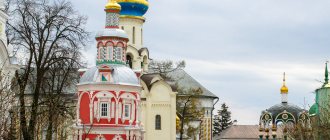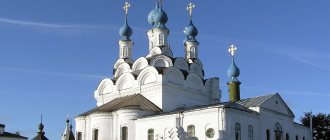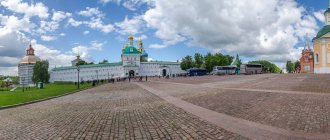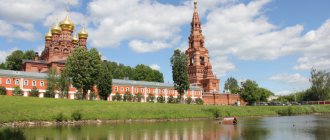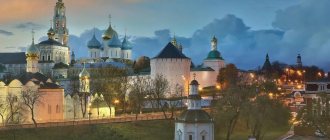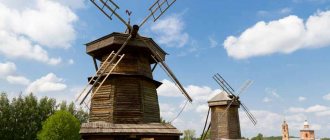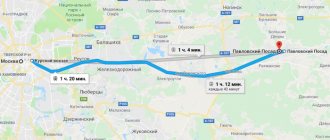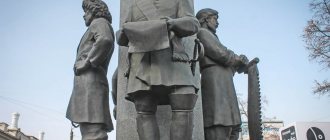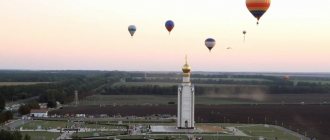Holy Trinity Lavra of Sergius
Holy Trinity Lavra of Sergius in Sergiev Posad
Moscow region
The Holy Trinity Monastery was founded near Moscow by St. Sergius of Radonezh in 1337. The monastery of the Life-Giving Trinity was attacked more than once - in the 13th century it was plundered by the Golden Horde Khan Edigei, in the 15th century the monastery withstood the siege of a 30,000-strong army of Polish invaders. In 1744, the Trinity Monastery was awarded the title of Lavra. For several centuries, pilgrims from all over the world have visited this place as one of the most revered Orthodox shrines.
The Trinity-Sergius Lavra houses a rare collection of handwritten and early printed books. Since the beginning of the 19th century, the Moscow Theological Academy, one of the largest religious educational institutions in Russia, has been located on the territory of the Lavra, in the former royal palaces. Among the most valuable shrines of the monastery are the relics of St. Sergius of Radonezh, Maxim the Greek and Anthony of Radonezh, the Tikhvin and Chernigov icons of the Mother of God.
Sergiev Posad State Historical and Art Museum-Reserve
Sergiev Posad Museum-Reserve - Main…
Sergiev Posad district
Academician Dmitry Likhachev called this museum “The Hermitage of Russian culture of the 14th–20th centuries.” The Sergiev Posad Museum-Reserve is one of the largest museums in the Moscow region; it houses the ancient collection of fine and applied art of the Trinity Lavra of St. Sergius. The exhibition centers on works by masters of the Moscow art school of the 14th–17th centuries.
The museum contains one of the largest collections of Russian folk art in Russia - painting and wood carving, metal working, printed cloth, peasant costume. The local history collection of the reserve introduces the history of Sergiev Posad, the architectural appearance of the city and its famous residents.
Chernigov men's monastery of the Trinity-Sergius Lavra
Chernigov men's monastery of the Trinity-Sergius Lavra in Sergius...
Moscow region
In the 40s of the 19th century, three kilometers from the Trinity-Sergius Lavra, the Monk Anthony founded the Gethsemane Chernigov monastery - a separate monastery for hermit monks. The secluded picturesque place became a haven for more than 400 monks. Anthony commanded that the monastery be kept in simplicity and austerity - even the church utensils were made of wood. Saint Philaret of Moscow wrote: “Simplicity... is the hope of the monastery. May the Lord preserve this." After the revolution, the monastery was closed, and monastic life here resumed only in the 90s of the 20th century.
The Chernigov monastery is named after the miraculous Chernigov Icon of the Mother of God, brought to the monastery at the end of the 19th century, and the Gethsemane monastery is named after the Garden of Jerusalem, where the Mother of God is buried. To this day, the monastery has preserved cave temples, monastic cells, a holy spring and ancient monastery buildings.
Factory matryoshka
In 1904, a factory of nesting dolls was created, which in Soviet times, having significantly expanded its range, was called “Zagorsk Toy Factory No. 1”, and in the 1990s it was renamed “Art Products and Toys”.
Today, the enterprise has preserved the previously developed tradition and technology of the “Zagorsk matryoshka” - they are still made and painted by hand by specially trained craftsmen, which preserves the uniqueness of this craft.
The company produces traditional tumbler toys from Soviet times (developed by the Toy Research Institute), as well as dolls dressed in authentic ethnographic costumes of the provinces and districts of Russia.
Related Articles
Toy Museum, Sergiev Posad
Bogorodsk Carving Museum
Sergievskaya fly carving
Copyright
The article was prepared based on materials: Wikipedia, CC BY-SA 3.0, photos: 1,3, 5 - Guide to Russian crafts CC BY-SA 3.0; 3 - Hampelman & matryoshka, CC BY-SA 3.0, 2 - K. Inkh, 1984, CC BY-SA 3.0.
State Historical, Artistic and Literary Museum-Reserve "Abramtsevo"
Historical, artistic and literary museum-reserve…
Sergiev Posad district
On the banks of the Vori River, not far from Sergiev Posad, the Abramtsevo Museum-Reserve is located. In the middle of the 18th century, a manor appeared here, which became a source of inspiration for famous writers and artists. In 1843, the writer Sergei Aksakov acquired the estate; writers Nikolai Gogol and Ivan Turgenev, actor Mikhail Shchepkin, and historian Mikhail Pogodin liked to stay with him. In 1870, the house was bought by philanthropist Savva Mamontov - then the Abramtsevo art circle was formed here, which included artists Konstantin Korovin, Ilya Repin, Valentin Serov, Vasily Polenov, Viktor Vasnetsov and others.
After the revolution, a museum was opened in the estate, but the traditions of the Mamontov circle did not stop - in the 20th century, artists Pyotr Konchalovsky, Igor Grabar, Ilya Mashkov, sculptors Boris Korolev and Vera Mukhina worked in Abramtsevo. Today, the collection of the Abramtsevo Museum contains more than 25 thousand exhibits - photo archives and personal belongings of the former owners of the estate, graphics, paintings, sculptures and works of folk art.
What to see
Today the Lavra is a functioning monastery, the spiritual center of Orthodox Russia. The monastery complex consists of 45 buildings and monuments. Now 300 church ministers live here. The main gate of the Lavra is the Saints with the gate church of John the Baptist. Behind them is the largest building - the main Cathedral of the Assumption of the Virgin Mary. Adjacent to the cathedral from the north-west is a small tent - the tomb of the Godunovs. It contains the remains of Tsar Boris, his wife Maria, son Fyodor and daughter Ksenia. Since the 17th century, Russian metropolitans began to be buried here. Next to the cathedral is a church in honor of the Descent of the Holy Spirit on the Apostles. In the Trinity Cathedral, the interior paintings of the temple were performed by Andrei Rublev and Daniil Cherny. In the 17th century, due to poor condition, the frescoes were replaced with new ones. The iconostasis, consisting of 40 icons from the 15th century, containing works by Rublev, has survived. The famous Trinity icon was placed in the Tretyakov Gallery in 1930, and a copy was placed in its place. Next to the Trinity Cathedral, in the Metropolitan Chambers, there are the Patriarchal Chambers.
The most ancient churches in Sergiev Posad are the Church of the Entry into the Temple of the Blessed Virgin Mary and the Church of the Martyr Paraskeva Pyatnitsa, built in 1547 on the site of a wooden parish church.
Church of Peter and Paul - Church in honor of the Renewal of the Temple of the Resurrection of Christ, also known as Peter and Paul Church (early 18th century) is located north of the Trinity-Sergius Lavra in the former Kokueva Sloboda.
Among the attractions are also the Ascension, Assumption and Elias churches, built in the second half of the 18th century. The monastery hotel was built later, in 1823. The Trading Rows of the early 20th century and the Pyatnitsky Well (late 17th - early 18th centuries) are interesting.
The Rostov boyars, the parents of Sergius of Radonezh - Cyril and Maria, moved to the village of Radonezh from Rostov the Great. In 1988, a monument to St. Sergius was erected near the Transfiguration Church. At its foot lies a stone with the inscription “Grateful Russia to Sergius of Radonezh.” The tomb with the relics of Cyril and Mary is located in the active Khotkovsky monastery. The main buildings of the monastery - the Intercession Cathedral and St. Nicholas Church - date back to the 18th and 19th centuries.
Near Khotkovo there is the picturesque Abramtsevo estate, where the famous Russian writer S.T. lived. Aksakov. Many writers, actors, scientists, and public figures have visited here: N.V. Gogol, I.S. Turgenev, actor M.S. Shchepkin and others.
Later, the estate passed to a major industrialist and philanthropist S.I. Mamontov, whose name is associated with the construction of Russian railways and the founding of the Moscow Private Russian Opera. The greatest Russian artists create in the estate - V.A. Serov and V.M. Vasnetsov, M.A. Vrubel and others. F.I. sang here. Chaliapin. In 1999, a monument to S. Mamontov (sculptor V. Chukharkin) was unveiled on the station square of the city of Sergiev Posad.
The Chernigov monastery is located three km southeast of the Lavra. Pilgrims always wanted to see the icon of Our Lady of Chernigov, the Cave Church and receive the blessing of the monks.
In the Hermitage, located 6 km southeast of the Lavra, the future Patriarch of All Rus' Pimen (Izvekov) took monastic vows. Since 1993, the monastic hostel has been restored here. The wooden monastic cells, stone temple, and bell tower have been preserved.
In the village of Semkhoz in 1995, in memory of the innocently murdered archpriest, priest, scientist, writer, Alexander Men, the Chapel-Temple of the Beheading of John the Baptist was erected at the site of his death.
12 km from Sergiev Posad, in the village of Vozdvizhinskoye, the stone Church of the Exaltation of the Cross from 1848 has been preserved.
According to legend, 14 km southeast of Sergiev Posad near the village of Vzglyadnevo, through the prayer of St. Sergius, the Gremyachiy Waterfall appeared. Its Height is 25 meters. Water has healing properties.
“In the ancient village of Deulino, in the northern part of Sergiev Posad, in December 1618, a truce was concluded between Russia and Poland. In memory of this, a wooden church was erected in the name of St. Sergius of Radonezh. There is a stone church here.
In 1920, the Historical and Art Museum-Reserve was organized. Currently it is located in the city center, in a bank building. Unique works of icon painting and artistic sewing, products made of precious metals and folk art, collections of decorative, applied and fine arts are presented here. Materials on archeology and history of the monastery and the city are exhibited. Works of peasant art are presented (carving and painting on wood, printed material, metal, costume, hats).
In the city of Sergiev Posad, the birthplace of the famous Russian nesting doll, there is the only toy college in the country. In the toy museum you can trace the history of Russian toys and learn about toys from other countries.
